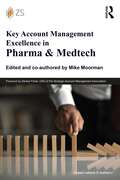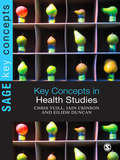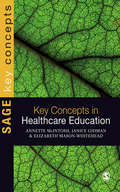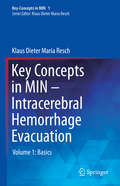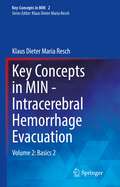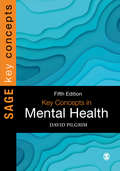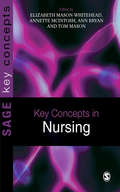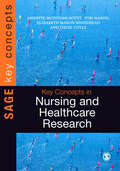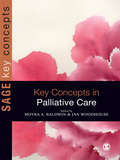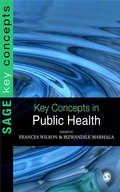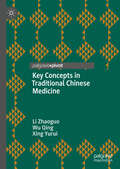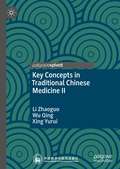- Table View
- List View
Kew: The science and mythology of medicinal plants (Royal Botanic Gardens, Kew)
by Emma WaylandFor centuries we have harnessed the ancient wisdom of botanical healing, with plants used for a multitude of remedies that nurture both body and soul.Kew: The Apothecary's Garden is a fascinating exploration of nature's pharmacy and the healing power of plants, from soothing hops, chamomile and valerian, and invigorating guarana, maca and ginseng, to the infection-fighting turmeric and tea tree and the immunity-boosting turkey tail mushroom. Herbal remedies, natural tinctures, and the historical and botanical background of plants are revealed through expert text and beautiful illustrations from the renowned Kew archive.This curious history of plants that heal describes the incredible properties of over 60 species. Exploring the original folk remedies they inspired and the science behind them, this is the weird and wonderful story of how humans have harnessed nature's apothecary.
Key Account Controlling in der pharmazeutischen Industrie
by Sabine RinauerDas deutsche Gesundheitssystem ist ein komplexes Regulierungsgefüge. Damit die Marktteilnehmer die Konsequenzen ihres Handelns einschätzen können, werden die Kenntnis von Interdependenzen und die frühzeitige Information über Veränderungen der Rahmenbedingungen immer wichtiger. Durch die Konsolidierung der Nachfragestrukturen gewinnt die Fokussierung auf die zentralen Schlüsselkunden für die Arzneimittelhersteller an strategischer Bedeutung. Die damit verbundene Veränderung im absatzwirtschaftlichen Geschäftsmodell verändert den Informations- und Koordinationsbedarf maßgeblich und stellt somit neue Anforderungen an das Controlling. Neue praxistaugliche Instrumente zur Entscheidungsunterstützung und Verhaltenssteuerung im pharmazeutischen Key Account Management werden benötigt.
Key Account Management Excellence in Pharma & Medtech
by Mike MoormanKey Account Management Excellence in Pharma & Medtech is designed to help life sciences practitioners develop and execute innovative and effective key account management (KAM) strategies and capabilities. Pharmaceutical and medtech companies are increasingly pursuing KAM in response to the rapid rise of large, sophisticated and complex healthcare provider and payer systems and groups. Those that invest the time to get KAM right will protect their business and grow with these rising customers. This book is groundbreaking in both its scope and its tailoring of leading KAM practices specifically for life sciences. The central theme is that "key account management is an organization-wide business strategy, not just a role or a sales-specific initiative." KAM is a strategy focused on providing unique offerings and value through an orchestrated, cross-functional, go-to-market model designed specifically to address the needs and engagement preferences of a unique segment of customers. The insights and practices shared in this book are designed to be a valuable reference at every stage of the KAM journey. The book has been designed to facilitate a common language and deep understanding of KAM issues and leading practices organization-wide—particularly for life sciences leaders, account managers and cross-functional team members responsible for building, transforming and supporting their organization’s KAM strategies and capabilities.
Key Concepts and Issues in Nursing Ethics
by P. Anne ScottShort case studies, based on real stories from the health care arena, ensure that each chapter of this book is rooted in descriptions of nursing practise that are grounded, salient narratives of nursing care. The reader is assisted to explore the ethical dimension of nursing practice: what it is and how it can be portrayed, discussed, and analysed within a variety of practice and theoretical contexts. One of the unique contributions of this book is to consider nursing not only in the context of the individual nurse - patient relationship but also as a social good that is of necessity limited, due to the ultimate limits on the nursing and health care resource. This book will help the reader consider what good nursing looks like, both within the context of limitations on resources and under conditions of scarcity. Indeed, any discussion of ethical issues in nursing should be well grounded in a conceptualisation of nursing that nursing students and practising nursing can recognise, accept and engage with. Nursing, like medicine, social work and teaching has a clear moral aim - to do good. In the case of nursing to do good for the patient. However it is vital that in the pressurised, constrained health service of the 21st century, we help nurses explore what this might mean for nursing practice and what can reasonably be expected of the individual nurse in terms of good nursing care.
Key Concepts and Issues in Nursing Ethics
by P. Anne Scott Shane M. ScottThis second edition offers updates, new topics, and new short case studies, based on real stories from the health care arena, ensuring that each chapter of this book is rooted in descriptions of nursing practise that are grounded, salient narratives of nursing care. The reader is assisted to explore the ethical dimension of nursing practice: what it is and how it can be portrayed, discussed, and analysed within a variety of practice and theoretical contexts. One of the unique contributions of this book is to consider nursing not only in the context of the individual nurse – patient relationship but also as a social good that is of necessity limited, due to the ultimate limits on the nursing and health care resource. This book will help the reader consider what good nursing looks like, both within the context of limitations on resources, during crises situations, and under conditions of scarcity. Indeed, any discussion of ethical issues in nursing should be well grounded in aconceptualisation of nursing that nursing students and practising nursing can recognise, accept and engage with. Nursing, like medicine, social work and teaching has a clear moral aim – to do good. In the case of nursing to do good for the patient. However it is vital that in the pressurised, constrained, post-COVID-19 pandemic health service of the 21st century, we help nurses explore what this might mean for nursing practice and what can reasonably be expected of the individual nurse, and the nursing profession, in terms of good nursing care.
Key Concepts in Health Studies (SAGE Key Concepts series)
by Dr Iain Crinson Chris Yuill Eilidh DuncanKey Concepts in Health Studies provides a much needed guide to the central concepts used across the subject, and offers the reader a comprehensive overview of the core topics, theories and debates. Drawing together the fundamentals within the disciplines of health, nursing, and social policy this book is an ideal text both for students studying health in a range of academic fields, and for health and social care practitioners. From ageism to public health, and gender to obesity, the book offers an exciting guide to the multidisciplinary field. Each entry features: -A snapshot definition of the concept -A wider discussion of the main issues -Case studies illustrating the application of theory to practice -Examples of further reading Highly readable, with clear indexing, and cross-referencing between entries, this is not only a student-friendly textbook that will enable the reader to dip into and update their knowledge of a particular key concept, but a valuable resource to anyone practicing in the health care field.
Key Concepts in Healthcare Education (SAGE Key Concepts series)
by Elizabeth Mason-Whitehead Jan Gidman Annette Mcintosh-ScottKey Concepts in Healthcare Education is a guide to the key theories, issues and practical considerations involved in healthcare education in the 21st century. It is aimed at those studying to be educators in both academic and practice settings, as well as supporting the continuing professional development of more experienced lecturers and practice educators. The book can be used as a reference source, a platform for further study and an essential text. The book comprises 40 succinct chapters each covering a topic and featuring - a definition of the concept - key points - discussion of the main issues - a case study to illustrate the application to practice, and - suggestions for further reading. For those developing or enhancing their knowledge and skills in education and mentorship in healthcare, Key Concepts in Healthcare Education is the ideal companion to learning.
Key Concepts in MIN - Intracerebral Hemorrhage Evacuation: Volume 1: Basics (Key-Concepts in MIN #1)
by Klaus Dieter ReschThis is the first of four volumes that together elaborate on an advanced minimally invasive neurosurgery (MIN) technique for cerebral hemorrhages, which makes it possible to prevent secondary injury by the hematoma and to preserve neurological function and accelerate neuropsychological recovery after the evacuation.It describes in detail the theoretical, technical and training procedures necessary to carry out successful intracerebral hemorrhage evacuations using MIN techniques. A combination of mouth-tracked microsurgery, neuro-sonography, neuro-endoscopy, LASER and sealing makes highly effective, minimally invasive evacuation of all types of hematomas possible. The MIN Key Concept, an advanced new model based on the Keyhole Concept and MIN techniques is also presented. Lastly, the scientific basics of MIN are discussed and summarized. A historical curriculum vitae is included in memory of the main pioneer of innovative MIN techniques, Prof. Axel Perneczky, to whom this book is dedicated.
Key Concepts in MIN - Intracerebral Hemorrhage Evacuation: Volume 2: Basics 2 (Key-Concepts in MIN #2)
by Klaus Dieter ReschThis book adds in chapter 1 and 2 the MIN-key techniques Laser and sealing, completing the 3 MIN-key techniques of the first volume. In chapter 3 the evolution of anatomy to a key-concept of MIN is described, presenting theory and reality of anatomical perspectives that can be used by the MIN-surgeon directly in the OR. Anatomy must be elaborated according to Gestalt-Theory to become a Key of MIN. Still anatomy is the "House of Medicine”, giving a mental place to all knowledge, theories and biological functions.The "surgical simulation concept" of chapter 4 as trainings environment follows, also as a key-concept of MIN. In this chapter we draw the line from Gestalt-Anatomy to a Surgical Simulation Application in Pathological Anatomy exemplified in aneurysm cases.Chapter 5 presents the best preservation technique of anatomical perishable matter, forming durable, dry and odorless specimen of unknown precision and beauty. The scientific value of this unique technique and the benefit for MIN are shown by many examples.With the Plastination gallery of chapter 6 the best head-plastinates and sheet-plastinates of head and brain complete the volume. Many of the specimen have been shown around the globe in the famous exhibitions “body worlds“ (Prof. Dr. G. v. Hagens/Inventor of Plastination).
Key Concepts in Mental Health
by David Pilgrim"This book wins on two levels: not only is there an extensive range of concepts presented (including some that are unexpected yet clearly relevant), there is also a succinct, thorough and critical dissection of each. Recommended, if not essential, reading for all student mental health professionals. " - Dr Steven Pryjmachuk, Head of Mental Health Division, School of Nursing, Midwifery and Social Work, University of Manchester Mental health is an area that new students and trainee practitioners often find bewildering. This book cuts through the stigma associated with this topic. It delivers bite-sized chunks of information that cover the central concepts and debates which shape contemporary views about mental health and illness. As this book shows, these key concepts not only influence our understanding of mental health, but also govern the provision of services for people with mental-health problems. Drawing together perspectives from sociology, psychiatry, psychology and ethics, the vital topics in mental health are examined in three parts: - PART ONE: Mental Health and Mental-Health Problems explores theories and understandings of mental health and illness - PART TWO: Mental Health Services looks at the structure and organization of mental health service delivery, past and present - PART THREE: Mental Health and Society studies the social context. This new edition adds 10 new concepts as well as updating the previous entries. New topics include childhood adversity, recovery, spirituality, well-being, social and cultural capital, quality of mental-health services, evidence-based practice, and work and mental health. This book will be invaluable for trainee health professionals, including clinical psychologists, social workers, nurses, counsellors and psychotherapists.
Key Concepts in Mental Health
by David PilgrimThis is the only text to give you a complete, concise overview of mental health and all the issues that surround it from a theoretical and practical point of view. Split into three sections, the book defines mental health and mental illness, examines the services and settings in which mental health care takes place and discusses the societal issues surrounding mental health. Made up of 63 bite-sized chapters, the book offers: · Definitions of the key concepts · Key points that you need to know for your study and practice · Further reading to help you expand your knowledge It will be essential reading for students of health, nursing, mental health, social work and social care. It is also valuable reading for students of counselling and psychotherapy.
Key Concepts in Mental Health (SAGE Key Concepts series)
by David PilgrimA classic and long-trusted resource that provides short summaries of all the key theories, concepts and terminology associated with mental health. Each entry is neatly summarised and thoroughly referenced giving the reader an immediate and thorough entry point to the subject. Structured into four sections, the text starts with entries related to Mental Health and Mental Abnormality, before moving onto Mental Health Services and Society. The new edition offers: 70 concise chapters including new entries on social networks and loneliness Updates across all chapters to align with contemporary, critical debates in mental health Appropriate consideration of the intersection of Covid-19 and mental health An essential guide for students of mental health studies, health, nursing, social work, education, psychology, counselling and psychotherapy.
Key Concepts in Mental Health (SAGE Key Concepts series)
by David PilgrimA classic and long-trusted resource that provides short summaries of all the key theories, concepts and terminology associated with mental health. Each entry is neatly summarised and thoroughly referenced giving the reader an immediate and thorough entry point to the subject. Structured into four sections, the text starts with entries related to Mental Health and Mental Abnormality, before moving onto Mental Health Services and Society. The new edition offers: 70 concise chapters including new entries on social networks and loneliness Updates across all chapters to align with contemporary, critical debates in mental health Appropriate consideration of the intersection of Covid-19 and mental health An essential guide for students of mental health studies, health, nursing, social work, education, psychology, counselling and psychotherapy.
Key Concepts in Mental Health (SAGE Key Concepts series)
by Professor David PilgrimNow in its 4th edition, this text continues to give you a complete and concise overview of mental health and all the issues that surround it from a theoretical and practical perspective. Restructured into 4 sections, the book starts by defining mental health and mental abnormality before examining the mental health services and the place mental health takes in society. Fully updated, the book offers: 66 bite-sized chapters including new ones on the Biopsychosocial Model, trauma and mindfulness Key points summarising what you need to know for study and practice Examples of further reading to help you expand your knowledge It is essential reading for students of health, nursing, mental health, social work and social care. It is also valuable reading for students of counselling and psychotherapy.
Key Concepts in Mental Health (SAGE Key Concepts series)
by Professor David PilgrimNow in its 4th edition, this text continues to give you a complete and concise overview of mental health and all the issues that surround it from a theoretical and practical perspective. Restructured into 4 sections, the book starts by defining mental health and mental abnormality before examining the mental health services and the place mental health takes in society. Fully updated, the book offers: 66 bite-sized chapters including new ones on the Biopsychosocial Model, trauma and mindfulness Key points summarising what you need to know for study and practice Examples of further reading to help you expand your knowledge It is essential reading for students of health, nursing, mental health, social work and social care. It is also valuable reading for students of counselling and psychotherapy.
Key Concepts in Mental Health (SAGE Key Concepts series)
by Professor David PilgrimNow in an updated fifth edition, this book provides readers with overviews of all the key theories, concepts and terminology associated with mental health, summarising them succinctly in a series of easily digestible yet expertly written entries. Structured into four sections, the text starts with entries related to Mental Health and Mental Abnormality, before moving onto Mental Health Services and Society. The new edition offers: 68 concise chapters including new entries on ADHD, Secondary Prevention, Challenges for Practitioners, and The Impact of Social Media on Mental Health. Updates across all chapters to make the content more in-line with contemporary critical debates in mental health, including new terminology and references to modern mental health services. A new contextualising introduction on the sticky subject of mental health terminology. Additional further reading examples and suggestions An essential guide for students of mental health studies, health, nursing, social work, psychology, counselling and psychotherapy.
Key Concepts in Mental Health (SAGE Key Concepts series)
by Professor David PilgrimNow in an updated fifth edition, this book provides readers with overviews of all the key theories, concepts and terminology associated with mental health, summarising them succinctly in a series of easily digestible yet expertly written entries. Structured into four sections, the text starts with entries related to Mental Health and Mental Abnormality, before moving onto Mental Health Services and Society. The new edition offers: 68 concise chapters including new entries on ADHD, Secondary Prevention, Challenges for Practitioners, and The Impact of Social Media on Mental Health. Updates across all chapters to make the content more in-line with contemporary critical debates in mental health, including new terminology and references to modern mental health services. A new contextualising introduction on the sticky subject of mental health terminology. Additional further reading examples and suggestions An essential guide for students of mental health studies, health, nursing, social work, psychology, counselling and psychotherapy.
Key Concepts in Nursing (SAGE Key Concepts series)
by Tom Mason Elizabeth Mason-Whitehead Annette Mcintosh-Scott Mrs Ann BryanNursing can be complex and challenging to new students and trainee practitioners. Key Concepts in Nursing provides a much needed guide to the central topics and debates which shape nursing theory, policy and contemporary practice. From assessment to ethics, and leadership to risk management, the book offers a comprehensive yet concise guide to the professional field. Each entry features: " a snapshot definition of the concept; " a broader discussion addressing the main issues and links to practice; " key points relevant to the entry; " case studies to illustrate the application to practice; " examples of further reading. Highly readable, with clear indexing and cross referencing, this is an ideal book for trainees to turn to for learning more about key issues in nursing practice and education. It meets the validation requirements of all training programmes and will also be invaluable for nurses continuing their professional education, those returning to practice and for mentoring.
Key Concepts in Nursing and Healthcare Research (SAGE Key Concepts series)
by Tom Mason Elizabeth Mason-Whitehead David Coyle Annette McIntosh-ScottResearch presents a dizzying array of terms and concepts to understand. This new book gives an overview of the important elements across nursing and health research in 42 short, straightforward chapters. Drawing on a range of perspectives from contributors with diverse experience, it will help you to understand what research means, how it is done, and what conclusions you can draw from it in your practice. Topics covered range from action research to systematic review to questionnaires. Every chapter includes a case study. It will be invaluable reading for nursing students at pre-registration level, undergraduate allied health students and for qualified practitioners needing a quick guide to the essentials. Annette McIntosh-Scott is Executive Dean in the Faculty of Health and Social Care at the University of Chester. Tom Mason was Professor and Head of Mental Health and Learning Disabilities at the University of Chester. Elizabeth Mason-Whitehead is Professor of Social and Health Care in the Faculty of Health and Social Care at the University of Chester. David Coyle is a Lecturer in the School of Healthcare Sciences at Bangor University.
Key Concepts in Palliative Care (Key Concepts (sage) Ser.)
by Moyra Baldwin Mrs Jan WoodhouseDo you need a succinct introduction to the key theories and principles of palliative care and their application to practice? Key Concepts in Palliative Care provides just this in a compact, fifty-concept guide to the field. Taking account of the government's "End of Life Care Strategy", contributors set out the key issues affecting practice across a range of health and social care contexts. The book covers topics ranging from dying and death to symptom management and spiritual care, backed up with practical examples. Each entry comprises: o a snapshot definition of the topic o key points o a discussion of the main debates o links to practice through thought-provoking case histories, and o suggestions for further reading. Key Concepts in Palliative Care is an ideal text and handy source of reference for health and social care professionals who are developing their knowledge and skills in palliative care.
Key Concepts in Public Health (SAGE Key Concepts series)
by Frances Wilson Andi Mabhala"This is a very good text for undergraduate students as it gives a broad overview of the concept of public health, utilising case studies to illustrate practical application. This book would be also be an excellent way for practitioners to increase their own knowledge of public health and could inform their own continuing professional development." Julie Lemprière, University of Gloucestershire Key Concepts in Public Health identifies fifty key concepts used across the discipline of public health in order to give the reader a broad perspective of the core topics relevant to training and practice. From epidemiology to health promotion, and ethics to leadership, the book offers an exciting guide to the multiprofessional field. Each entry features: - a snapshot definition of the concept - a broader discussion addressing the main issues and links to practice - key points relevant to the entry - case studies to illustrate the application to practice - examples of further reading. Highly readable, with clear indexing and cross referencing, this is an ideal book to turn to for learning more about key issues in public health practice and education. The clever structure means the book can be read in its entirety to support a programme of study or readers can use it to dip into and update their knowledge of a particular concept. It meets the validation requirements of all allied health and nursing training programmes and will also be invaluable for policy-makers and healthcare practitioners continuing their professional education.
Key Concepts in Substance Misuse (SAGE Key Concepts series)
by Mr Aaron PycroftDrug use is a major challenge for public services, healthcare professionals and policy-makers all over the world. This book offers a complete overview of the issues associated with substance misuse from an interdisciplinary perspective. It begins by providing a reference guide to the different psychoactive substances, looking at the biological and psychological impact of their use. Key issues in the effect drugs have on society are then addressed, before outlining methods of recovery and therapy. Chapters include: Reflective questions to challenge readers’ assumptions Case studies to help students understand the impact of substances on individuals Links to further resources to expand readers’ knowledge It will be valuable reading for those studying on degrees in criminology, health, nursing, social work and counselling.
Key Concepts in Substance Misuse (SAGE Key Concepts series)
by Mr Aaron PycroftDrug use is a major challenge for public services, healthcare professionals and policy-makers all over the world. This book offers a complete overview of the issues associated with substance misuse from an interdisciplinary perspective. It begins by providing a reference guide to the different psychoactive substances, looking at the biological and psychological impact of their use. Key issues in the effect drugs have on society are then addressed, before outlining methods of recovery and therapy. Chapters include: Reflective questions to challenge readers' assumptions Case studies to help students understand the impact of substances on individuals Links to further resources to expand readers' knowledge It will be valuable reading for those studying on degrees in criminology, health, nursing, social work and counselling.
Key Concepts in Traditional Chinese Medicine
by Li Zhaoguo Wu Qing Xing YuruiThis book offers a comprehensive overview of Chinese medicine terminology translation, defining the most central concepts in Chinese traditional medicine, providing simplified Chinese characters, Mandarin Pronunciation in pinyin, citations for 111 of the most key concepts in traditional Chinese medicine and culture. Covering definitions of terms relating to essence, qi, yin-yang theory, five elements and visceral manifestation in traditional medicine, it offers a selection of English versions of each term in addition to a standard English version, drawing on the translation history of traditional Chinese medicine. It provides a useful resource to understand the fundamental terms of traditional Chinese medicine and culture in Chinese and English, and their relevance to cross-cultural discourse.
Key Concepts in Traditional Chinese Medicine II
by Li Zhaoguo Wu Qing Xing YuruiThis book offers an overview of Chinese medicine terminology translation, defining the central concepts in Chinese traditional medicine, providing simplified Chinese characters, Mandarin Pronunciation in pinyin, citations for 110 of the most key concepts in traditional Chinese medicine and culture. Covering definitions of terms relating to visceral manifestation, meridians, etiology, pathogenesis, and treatment principles in traditional medicine, it offers a selection of English versions of each term in addition to a standard of English version, drawing on the translation history of traditional Chinese medicine. It provides a useful resource to understand the fundamental terms of traditional Chinese medicine and culture in Chinese and English, and their relevance to cross-cultural discourse.


